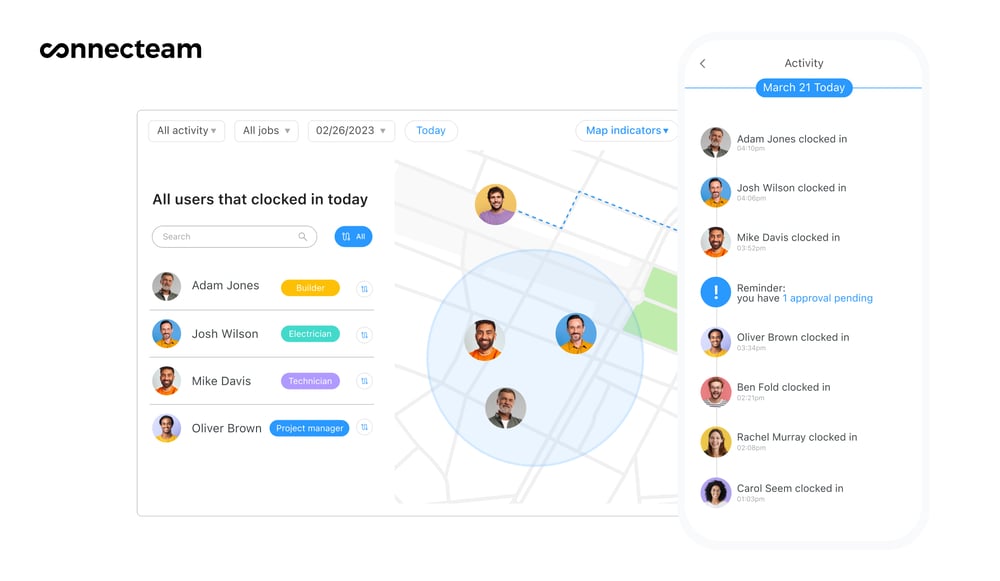Job abandonment can be confusing and frustrating for employers who don’t know why it’s happened or how to manage it. We explain what job abandonment is, why it happens, and how to deal with it effectively.
It’s shocking and frustrating when an employee you’ve invested time, resources, and trust in unexpectedly stops showing up to work.
Not to mention, it leaves you with so many things to think about. Why did they leave? Is job abandonment illegal? What’s the protocol here? How can you minimize the impact on the team and business?
While it can feel overwhelming and demoralizing, job abandonment is more common than you think. But you must know how to handle it in the quickest and least disruptive way.
In this guide, we discuss what job abandonment is, why it occurs, and how it impacts your company. We also explain how to manage it correctly and provide top tips on preventing it in the future.
Key Takeaways
- Job abandonment is when a worker doesn’t show up to work for multiple days, without notice, and with no intention of returning to work.
- It can decrease productivity, lower team morale, and damage your reputation with workers and customers.
- The best way to deal with job abandonment cases is to stick to your company’s policies and labor laws, document every attempt to contact the employee, and eventually terminate employment if the worker doesn’t respond.
- You can prevent job abandonment by checking in with employees regularly, gathering feedback, and training them on the company’s attendance and absenteeism policies.
What Is Job Abandonment?
Job abandonment is when an employee leaves their job without giving notice to their employer and has no intention of returning to work. It typically involves a sudden, unexplained absence from work for an extended period.
Job abandonment is considered a breach of the employment agreement and can lead to disciplinary action or termination of employment.
This Might Interest You
The best time and attendance apps help you easily track when your team is working, taking approved time off, or unexpectedly absent.
Signs That an Employee Has Abandoned Their Job
Each company has its own job abandonment definition, often found in employment contracts, the employee handbook, or as an independent company policy. Moreover, there’s no universal number of absent days constituting job abandonment.
This is because job abandonment goes beyond just absenteeism. Here are some general signs that help define job abandonment:
- The employee fails to show up for work for multiple consecutive days. Company policies determine the exact number of days, but 3 or more days can be considered a “prolonged” period of absence.
- They haven’t communicated the reason for their absence, requested leave, or indicated any intent of voluntary resignation.
- They’ve removed their personal belongings from the workplace.
- They don’t respond to phone calls, emails, or any other attempts at contact made by managers or coworkers.
- They don’t inquire about their final paycheck or accrued benefits, signifying their lack of interest in their employment status.
- They haven’t returned company assets such as keys, access cards, or other equipment.
- There’s no attempt from the worker to return to work or make arrangements for someone to cover their absence.
- You’ve observed prior signs of disengagement or quiet quitting, such as decreased productivity, lack of interest in work, or expressed dissatisfaction.
Reasons Employees Abandon Their Jobs
Below are 8 common reasons employees might abandon their jobs.
Urgent personal situations
The employee might be facing a personal or family medical emergency that leaves no time for a formal resignation process.
Conflict or unresolved issues
Employees might feel triggered in their work environments due to ongoing conflicts, harassment, or other unresolved issues, driving them to abandon their jobs.
Avoidance of confrontation
Some workers abandon their jobs to avoid uncomfortable discussions or negative reactions from managers or colleagues about their decision to quit.
Burnout and stress
Severe burnout might cause employees to feel too emotionally drained or overwhelmed to undergo a proper resignation process.
Lack of engagement
Employees who are disconnected from their jobs or already quiet quitting might disregard the importance of letting their employers know they’re leaving.
Immediate job opportunities
Some workers might abandon their jobs to avoid a notice period and secure a new job that requires an immediate start.
Mental health concerns
Serious mental health issues can impair an individual’s decision-making and ability to follow standard resignation procedures.
Limited awareness of procedures
In rare cases, employees may not be fully aware of proper resignation processes, what is considered job abandonment, or the consequences of it.
This Might Interest You
Read our complete article about why good employees leave and how to retain them.
Consequences of Job Abandonment
The sudden departure of an employee from work, without any explanation or intent to return, can have knock-on effects on the rest of their team and your company overall. Some of these are listed below.
Decreased productivity
When a worker abandons their job without notice, it might disrupt the workflow and lead to unfinished tasks, missed deadlines, and other problems with the team’s productivity.
Increased workload for other team members
Coworkers might need to take on additional responsibilities to complete the remaining tasks in the abandoned workload. This could lead to increased stress and potential burnout.
Poor team morale
The sudden departure of a colleague can lower team morale and cause uncertainty and anxiety about the company’s stability or the team’s ability to function effectively.
Reputational damage
Job abandonment, especially when it occurs repeatedly, can damage your company’s reputation and lead to concerns about its ability to retain talent.
Abandonment of customer-facing roles, in particular, can affect service and customer satisfaction and even lead to losing clients.
Recruitment and training expenses
Losing an employee is costly. You’ll need to bear the expenses of hiring a replacement worker and onboarding and training them on the job.
Loss of institutional knowledge
Although you can recruit a replacement with suitable skills, you’ll lose the departing employee’s specialized knowledge about your company and its working practices.
Legal and compliance issues
Depending on employment laws and company policies, job abandonment could lead to legal issues and expenses, especially if it isn’t handled with proper procedures. For instance, an employee can file a lawsuit if they have any reason to believe their employment was unfairly terminated.
Did You Know?
Connecteam lets you maintain a company knowledge base where you can upload unlimited training manuals, standard operating procedures, and more. This makes it easy to minimize the loss of institutional knowledge and get replacement workers up to speed quickly.
Get started with Connecteam for free today!
How To Handle Job Abandonment
Follow the below steps to reduce problems and stay compliant when dealing with job abandonment cases.
Verify that it’s job abandonment
First, ensure that the type of absenteeism aligns with what is considered job abandonment. Check attendance records to verify that the worker hasn’t been to work—usually for more than 3 consecutive days.
Next, contact the employee via phone calls, emails, or text messages—to check in on them. It’s important to stay calm and empathetic and give the employee a chance to explain their absence. They could be facing a personal emergency and should feel cared for and supported by the company.
If the employee doesn’t respond to this initial attempt, reach out to their coworkers to check if the employee has made contact with any of them. It could be that they were unable to connect with their manager about their absence and left a message with a coworker instead.
Only proceed with the next steps once you’re satisfied that the case meets the job abandonment definition and neither you nor the worker’s colleagues have been able to make any initial contact with the worker.

Did You Know?
With Connecteam’s time clock app, you can download time and attendance reports by employee, department, location, and more in just a few clicks.
Refer to labor laws, company policies, and established protocol
Many US states follow at-will employment, meaning an employer can terminate their workers’ contract at any time, without reason. But, a worker can still take you to court if they have reason to believe the decision was discriminatory or violated their employment contract.
Therefore, it’s critical to thoroughly review applicable labor laws and your company’s policies and procedures related to absenteeism, job abandonment, and termination. Ensure your actions align with these guidelines.
For example, your company’s job abandonment definition may constitute a prolonged absence without notice for 5 or more consecutive days. In this case, you must wait for the 5-day period to end to claim that the absence is what is considered job abandonment.
Carefully following employment laws and company policies is the best way to protect yourself from future lawsuits or other troubles.
Pro Tip
If you don’t have a clear policy on job abandonment, seek legal guidance regarding the appropriate steps to take.
Assign a contact person
Establish who’s responsible for contacting the worker from here. For example, it could be their manager, a department head, or an HR professional. (Depending on your professional relationship with the employee, this may be you.)
You can also consider assigning the task to the manager initially and changing this to HR after a certain number of attempts have been made.
Continually attempt to contact the employee
The appointed contact person (either yourself or someone else) must continue reaching out to the employee, following the processes and communication methods outlined in your employee handbook.
Here’s what the protocol might look like:
- Day 1: After your initial attempts to reach the employee, contact them via email, phone, work chat, or text message again to find out why they’ve missed work and when they plan to return.
- Day 2: If you still haven’t heard back after 24 hours, reach out to their emergency contact to check if they know anything about the employee’s absence or circumstances. Request them to ask the employee to contact you.
- Day 3: Finally, you can move to sending formal communications to the employee.
It’s important to wait 24 hours between each step to avoid overwhelming the employee if they’re in a challenging situation.
Did You Know?
Connecteam’s online team chat is an easy way to contact your workers no matter where they are. Plus, Connecteam doubles as an employee directory app. It lets you store contact details for workers and their emergency contacts, making it easy to reach out when required.Get started with Connecteam for free today!
Send formal communication to the employee
The next step is to send the employee a written letter to their registered home address. Include the following points in the letter:
- Dates they missed work
- Contact attempts made so far, including dates and communication methods used
- The company’s expectations and policies around continued absence
- A deadline—for example, 1 week—to respond by
At the end of the letter, explain that if they don’t respond, the company will terminate their employment on the basis of job abandonment.
Job abandonment letter template
Here’s a template you can use to start writing your job abandonment letter. Remember to customize it to your company’s policies.
[Company Letterhead]
[Date]
[Worker’s Name]
[Worker’s Address]
Subject: Notice of Absence and Job Abandonment
Dear [Full Name],
I hope this letter finds you well.
We regret to inform you that your absence from work without explanation has raised concerns. You have not reported to work or provided any communication regarding your absence since [last date of attendance at work].
Per our company’s absenteeism policy, you are expected to communicate any unexpected absence or inability to work due to personal reasons, emergencies, or health issues.
We have made multiple attempts to reach out to you through various channels, including: [list attempts made, dates, and methods of attempts]. Unfortunately, we have not received any response as of [today’s date].
Due to your continued absence without communication, we consider this situation job abandonment.
Please consider this letter a formal notice regarding your absence and the potential consequences of job abandonment in line with our company’s policies.
We request that you contact [appointed contact person] at [contact details] by [specified timeframe—for instance, 1 week] from the date of this letter to discuss the circumstances surrounding your absence and your intention to return to work.
Failure to respond by [deadline date] may result in further action, including termination of employment.
We hope to resolve this matter promptly and await your reply.
Sincerely,
[Your Name]
[Your Position]
[Company Name]
Initiate termination procedures
If you don’t hear back from the worker by the deadline noted in your formal letter, send them a letter confirming the termination of employment in writing. As best practice, also send a copy of the letter via email.
You’ll need to follow standard termination procedures, including the following:
- Paying out all the compensation the former employee is due, including any accrued paid time off.
- Offering a transition to COBRA for their health insurance, if applicable.
- Retrieving company property, such as laptops, access cards, and other equipment.
Document everything
Create a case file for the employee, either physically or digitally, and ensure you document every absence carefully.
Additionally, save information about all your attempts to contact them—including every email, chat, text message, call, no-show meeting invite, and more.
Also, store copies of any letters sent, prior discussions or warnings about attendance, and other relevant communications.
These records can help protect you in a court of law if a process ends in termination and the employee sues.
Did You Know?
You can use Connecteam’s team documents center to securely store employee records, including any records relating to the job abandonment process.
Remain flexible where appropriate
In some cases, you may hear back from the employee during the process or after termination with an explanation of their absence.
For example, suppose there were extenuating circumstances, such as a medical emergency, that left them unable to communicate with the team. In that case, you may choose to permit an extended period of leave for the employee or even hire them back if they’d been terminated.
Handling the situation with empathy, sensitivity, and confidentiality shows that you care about your employees’ well-being.
Reflect and improve
Once you’ve resolved the situation, take some time to reflect on the process. For example, if you find out why the worker abandoned their job, you can use this information to prevent job abandonment in the future.
The process may also have shed light on weak or incomplete company policies you can now update and fix for a smoother process in the future.
Best Practices for Handling Job Abandonment
Consider these best practices to manage job abandonment effectively.
Establish clear policies

There’s no universal set of criteria to explain what job abandonment is. So, workers need to understand what your company considers job abandonment—such as how many days of unnotified absence counts as job abandonment.
You should implement clear policies on attendance and absenteeism, clearly specifying how, when, and who workers should contact in case of absences. Add these to your employee handbook. Additionally, consider adding clauses regarding job abandonment into employment contracts for an added layer of protection.
You can also provide examples of scenarios constituting job abandonment—e.g., a worker failing to return to work after leave.
Stay consistent
Apply policies and procedures consistently across all employees. For example, don’t alter your job abandonment process for an employee who was a poor performer or had ongoing conflicts with team members. Doing so would constitute discrimination and unfair treatment.
Prevent job abandonment in the future
The best way to deal with job abandonment is to avoid the situation in the first place. Use the below methods to spot and address any emerging concerns that could lead to employees abandoning their jobs.
- Foster an open-door policy where workers feel comfortable discussing concerns or reasons for dissatisfaction without the fear of retaliation.
- Educate employees about company policies, including those around absenteeism, and the importance of abiding by them.
- Monitor attendance patterns and proactively address trends before they escalate into job abandonment.
- Offer support through flexible schedules, employee assistance programs, and so on to help workers cope with their circumstances rather than turn to job abandonment.
- Conduct regular employee surveys to identify any themes around disengagement or job dissatisfaction that need addressing.
- Offer employees some flexibility with notice periods to motivate them to give proper warning before leaving.
- Celebrate employees who resign voluntarily with gestures such as good wishes, leaving parties, and more to eliminate employees’ fear of resigning.
Pro Tip
Use an all-in-one employee engagement app like Connecteam to manage your workforce better and encourage a positive work environment. It offers employee survey tools, training, recognition, and much more in a single platform.
Bottom Line on Job Abandonment
Job abandonment, while common, can be confusing and disappointing. In addition to disrupting work and team morale, job abandonment can lead to legal and reputational issues for your company if mishandled. The best way to prevent this is to follow labor laws and your company’s established job abandonment policies and protocols.
When faced with an employee who has abandoned their job, repeatedly contact them through calls, emails, and text messages. Then, send a formal letter with a firm deadline for response.
If the employee doesn’t respond within the stated deadline, terminate the employment per your standard procedures. Be sure to document every absence and contact attempt to keep yourself legally protected in the event of a lawsuit.
FAQs
Is job abandonment illegal?
Job abandonment isn’t illegal, but employees can face other consequences associated with abandoning their roles without notice. For example, it could cost them their reputation and even make it difficult to get letters of recommendation from the employer. In some industries, such as healthcare, the worker could even lose their license.
What should I do if a dismissed worker leaves their belongings in their abandoned workplace?
If an employee leaves their belongings at their abandoned workplace, attempt to contact the worker to collect them. Send them a written letter with a deadline to retrieve their items. If they don’t respond, seek legal advice about whether you can dispose of or donate the belongings.

